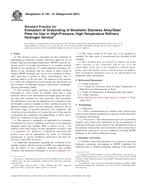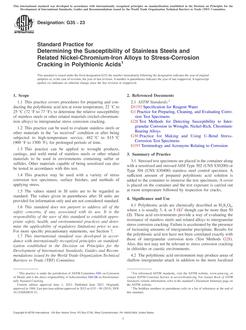
ASTM G146-01(2007)
1.1 This practice covers a procedure for the evaluation of disbonding of bimetallic stainless alloy/steel plate for use in refinery high-pressure/high-temperature (HP/HT) gaseous hydrogen service. It includes procedures to (1) produce suitable laboratory test specimens, (2) obtain hydrogen charging conditions in the laboratory that are similar to those found in refinery HP/HT hydrogen gas service for evaluation of bimetallic specimens exposed to these environments, and (3) perform analysis of the test data. The purpose of this practice is to allow for comparison of data among test laboratories on the resistance of bimetallic stainless alloy/steels to hydrogen-induced disbonding (HID).
1.2 This practice applies primarily to bimetallic products fabricated by weld overlay of stainless alloy onto a steel substrate. Most of the information developed using this practice has been obtained for such materials. The procedures described herein, may also be appropriate for evaluation of hot roll bonded, explosive bonded, or other suitable processes for applying stainless alloys on steel substrates. However, due to the broad range of possible materials, test conditions, and variations in test procedures, it is up to the user of this practice to determine the suitability and applicability of these procedures for evaluation of such materials.
1.3 This practice is intended to be applicable for evaluation of materials for service conditions involving severe hydrogen charging which may produce HID as shown in Fig. 1 for stainless steel weld overlay on steel equipment (see Refs 1 and 2 in Appendix X1). However, it should be noted that this practice may not be appropriate for forms of bimetallic construction or service conditions which have not been observed to cause HID in service.
1.4 Additional information regarding the evaluation of bimetallic stainless alloy/steel plate for HID, test methodologies, and the effects of test conditions, materials, and welding variables, and inspection techniques is given in Appendix X1.
1.5 The values stated in SI units are to be regarded as standard. No other units of measurement are included in this standard
1.6 This standard does not purport to address all of the safety concerns, if any, associated with its use. It is the responsibility of the user of this standard to establish appropriate safety and health practices and determine the applicability of regulatory limitations prior to use. See Section 6 for additional safety information.
Product Details
- Published:
- 05/01/2007
- Number of Pages:
- 6
- File Size:
- 1 file , 110 KB
- Redline File Size:
- 2 files , 210 KB

